Yes, I have Japanese maples. Hundreds, thousands, perhaps millions! Or more.
In the soil below the Bloodgood maple, and the Burgundy Lace, beneath the two Seriyu maples the seedlings are as thick as pachysandra. I haven’t the heart to pull them when so many people spend their hard earned dollars for these treasures, but eventually they must go, either to be potted for a friend to take home to their garden or pulled and thrown in the compost heap.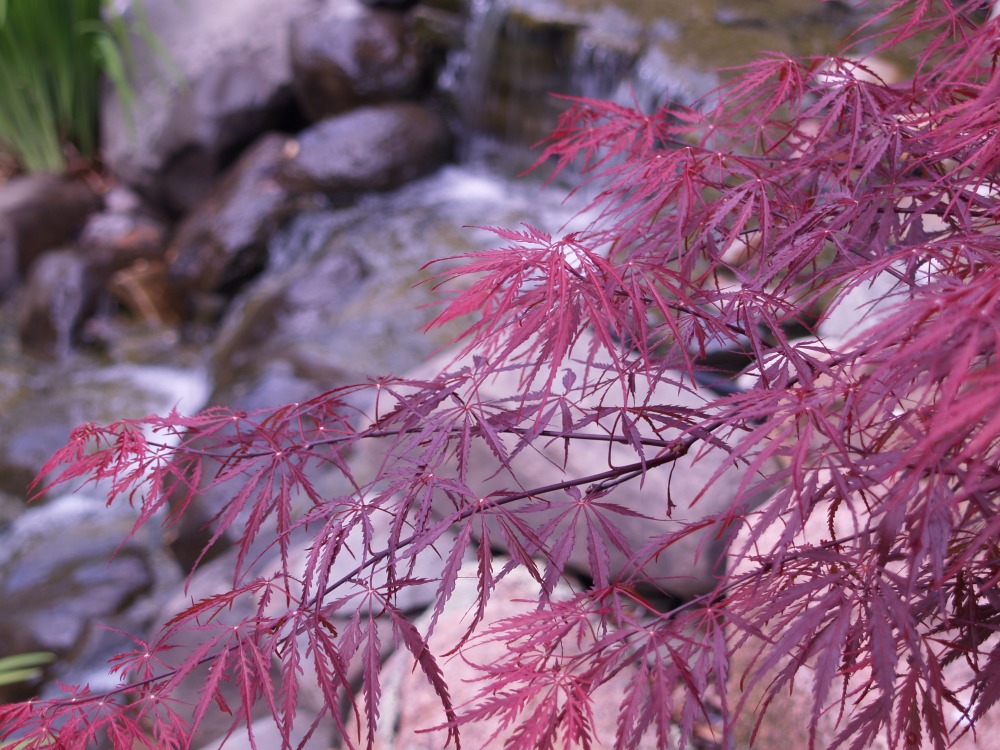
A few seeds that were carried by the breezes across the garden have grown almost two feet tall, but they are not positioned appropriately, too shady or too close to this or that, and so they wait for some divine guidance that will provide me with inspiration to give them a proper home. If the answer doesn’t arrive soon, the small maples will have to go.
Some of the seedlings appear identical to their nearby parent, and other oddballs bear no resemblance, as is the case for many plants that do not grow true from seed. I wish that I had adequate space to plant a hundred or two of the oddballs to see what character they would grow into, but my meager acre garden is so full at the moment that no matter how much I crave to add another Japanese maple or two, I can’t.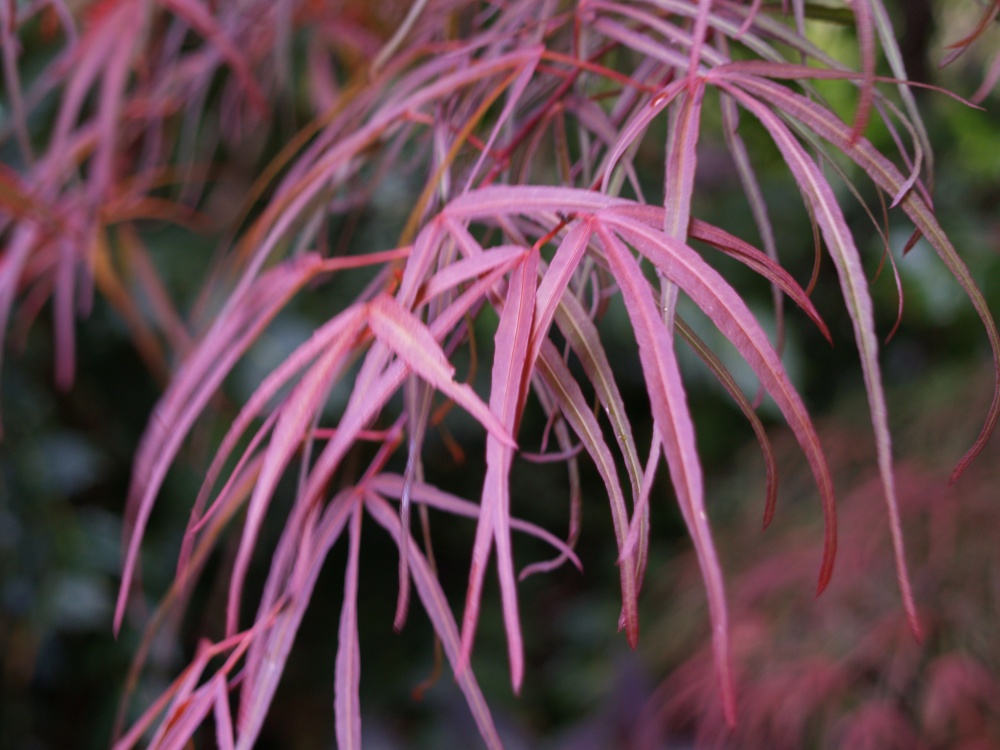
In my twenty-two years old garden I have accumulated collections of a number of trees, dogwoods, redbuds, magnolias, crapemyrtles, and too many other weeping and flowering trees to list, along with a few trees that would be considered primarily for shade (Beeches, birches, katsura, and an odd variegated leaf maple). The largest numbers of a single tree variety are Japanese maples, though I would not include the seedlings because they won’t be permanent residents.
I can recall fifteen Japanese maple varieties, though there are more than one of several types, and I am certain to forget a few in the recounting. And I should state before going any further that a collection this size is not something to be overly proud of. I am certain that there are more substantial collections in finer gardens than mine, with more varieties, and trees more grand, and to accumulate this number requires only money and the sweat of labor to plant them.
I don’t presume that I have accomplished anything, but they are magnificent trees through no effort on my part following their planting. I have been compelled to purchase one after the other, and to lust after still more, by the unique shapes and colors of their leaves, by their fall colors, and by their weeping and contorted growth habits.
I believe that there is a Japanese maple that is appropriate for nearly every size garden, though every maple is not appropriate for every garden. I have previously used the analogy that the mature size of some flowering trees is comparable to a two care garage, and if this helps to visualize their ultimate growth then there are Japanese maples that will grow to this size also. Even the most diminutive Japanese maples will grow to the size of a small car in a number of years, but they are often faster growing than you would expect (and the number of years is usually while you are still alive), so it is wise to provide them with an ample space to grow into.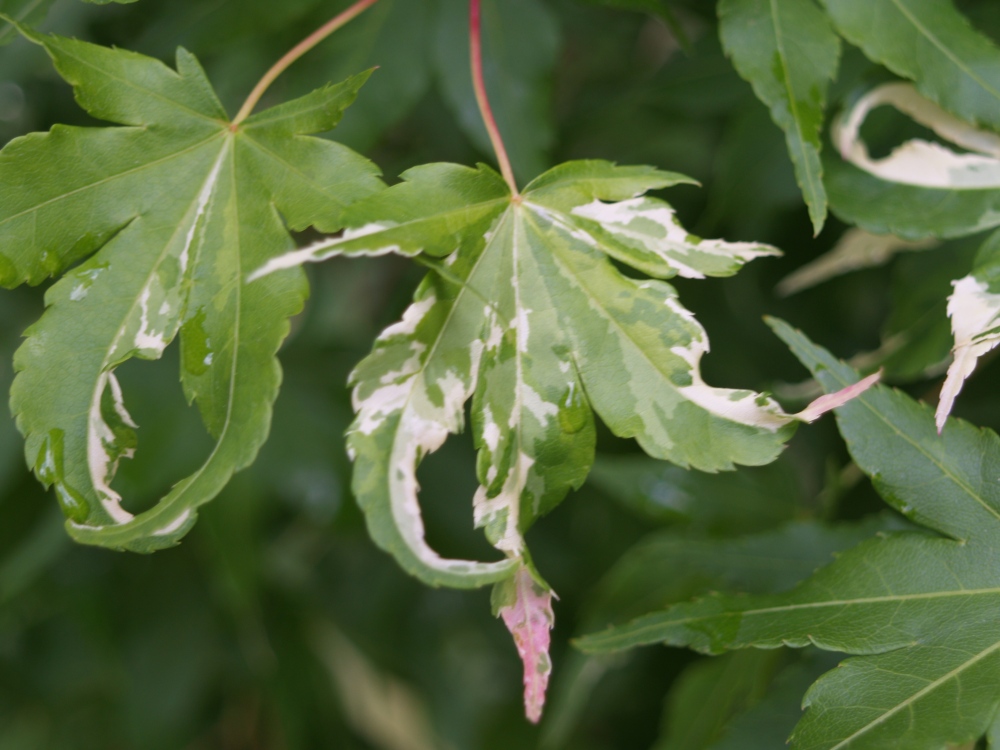
I have found little worse in a person’s garden than seeing a fine Japanese maple from two hundred seventy degrees round that must be butchered on the other quadrant so that it does not obstruct a walkway. All that is needed is a bit of forethought to plant the rather common weeping varieties no closer than three paces from a patio or path, though in a pinch I would be tempted to plant a pace closer if there is no alternative.
I am frequently asked which Japanese maples are the best, which ones I recommend, and of course I hesitate to give my personal regards because I appreciate different attributes in each, and you will probably not share my preferences. Nevertheless, I recognize the qualities that are most commonly accepted, and so I can heartily recommend the following Japanese maples.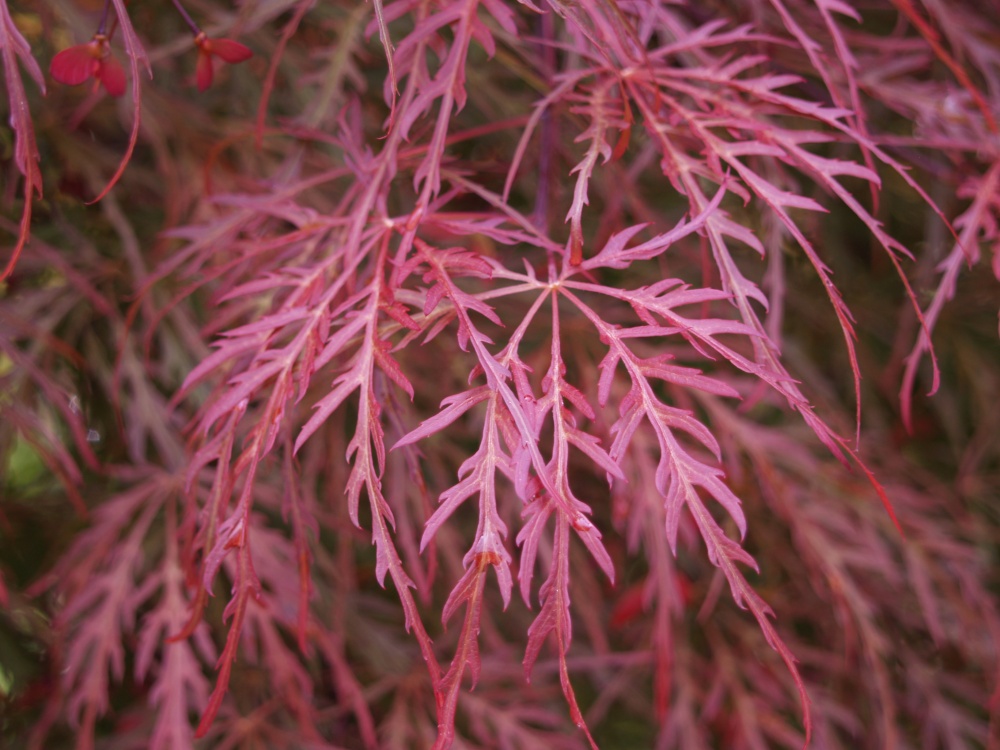
Weeping maples with red leaves My personal favorite is Garnet because it’s branching is somewhat upright and arching, rather than a strict weeping form. It grows larger than other common weeping types, and grows more open, but has more character than other weepers that can appear like giant red mushrooms. I have giant red mushrooms, and unfortunately no Garnet in my garden, but all the commonly sold weeping Japanese maples are marvelous trees, and you can do no wrong by acquiring Crimson Queen (above), Tamukeyama, Inaba shidare, Red Dragon, or Ever Red (and I have found that more people prefer giant red mushrooms anyway, and I am quite fond of mine).
Upright growing with red leaves The standard in this category is Bloodgood (above), and it is indeed a nearly flawless tree with deep red-purple leaves that retain their color through the summer’s heat (though all red leafed Japanese maples will fade some, and particularly in the first summer after planting. The hotter and more humid the climate, the more they fade). Very similar trees are Fireglow, a slower growing version of Bloodgood, and Red Emperor with slightly narrower leaves that emerge a week or more later in the spring and thus are less likely to be frost damaged. I have planted a number of other red leafed upright growing maples, and most are best suited for maple snobs, but the relatively common Burgundy Lace has proven to be fast growing with a fine spreading form, though its foliage is not as deeply colored as Bloodgood.
Green leafed maples There are, of course, weeping and upright growing green leafed Japanese maples, and there are folks who consider the red leafed maples to be too common, so they prefer the green. I have a weeping green leafed maple with layered arching branches that cascade over a small pond and waterfall in my garden. It is likely to be Viridis, and as you would expect there are fewer varieties of green maples on the market, but Sekimori is also a wonderful weeping green.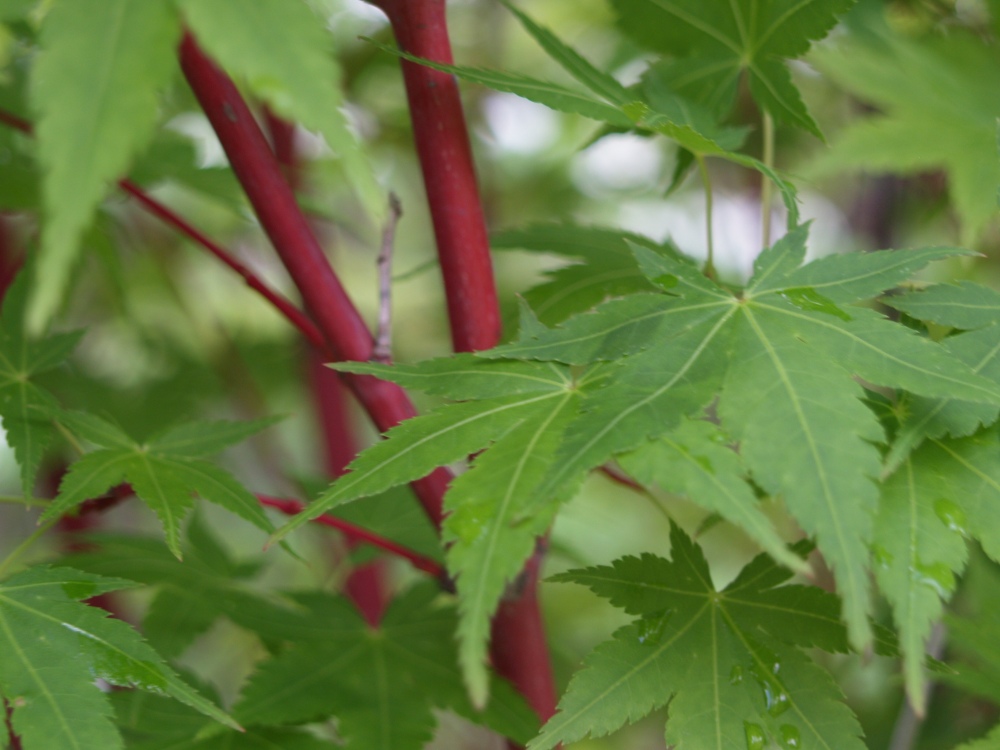
There are many splendid upright growing green varieties, and I would guess that Sangu Kaku (above), the coral barked maple is the most popular. I have found the foliage to be rather a drab green, but new stems are bright red and most striking after the leaves are shed. Osakazuki is a fine green leafed maple, and most notable for its crimson fall color and quick growth. I have mentioned at the start Seriyu maple, and there are two of these that arch over the front walk to my home so that you will walk under them as you approach the front entry. Seriyu features the finely dissected leaves that many of the weeping maples offer, but with an upright, spreading habit. I have planted mine much closer to the house than good design sense would dictate, but I did so knowingly and I believe that the result is delightful.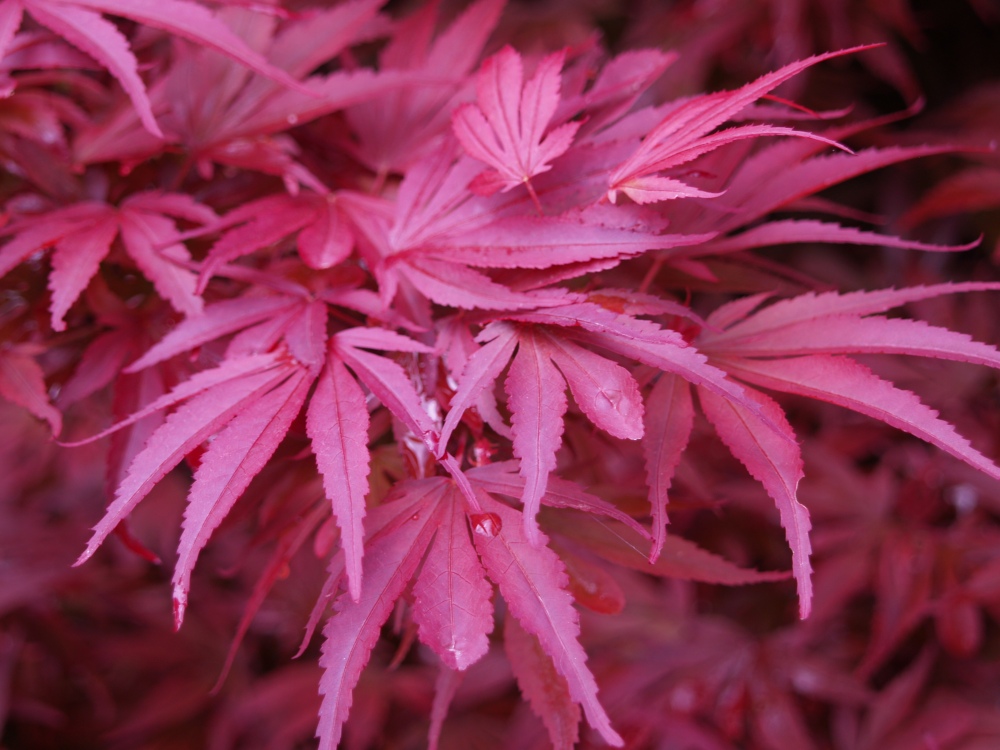
Maples with more unusual characteristics Shaina (above) is a somewhat dwarf Bloodgood, and indeed ten year old plants are reputed to be only six feet tall. Mine is half this age, but is only waist high, but very dense and the color fades less than Bloodgood in summer. Orido Nishiki’s foliage emerges green in April, then leaves begin to turn shades of green, cream, white, and pink by early May, and then as the spring progresses the leaves turn to a mix of mostly white, cream, and green, with only new leaves showing much pink. Another Japanese maple with variegated foliage is the slow growing Butterfly (below), with predominantly creamy white leaves with splashes of green.

The Lion’s Head maple, Shishigashira (above), is one of the most distinctive with crinkled green leaves, and its unusual foliage and slow growth rate ensure that it will have a limited place in the market, but it is among my favorites, and its gold to orange fall color, often beginning after all other trees have dropped their leaves, is magical. A somewhat similar, but faster growing green leafed maple with leaves that curl inward is Okushimo, which has wonderful late fall color and a more narrow upright shape than most Japanese maples. It is likely that many people would consider the odd curled foliage of these two as unattractive, and even diseased, but to me they are two of the most valued plants in the garden.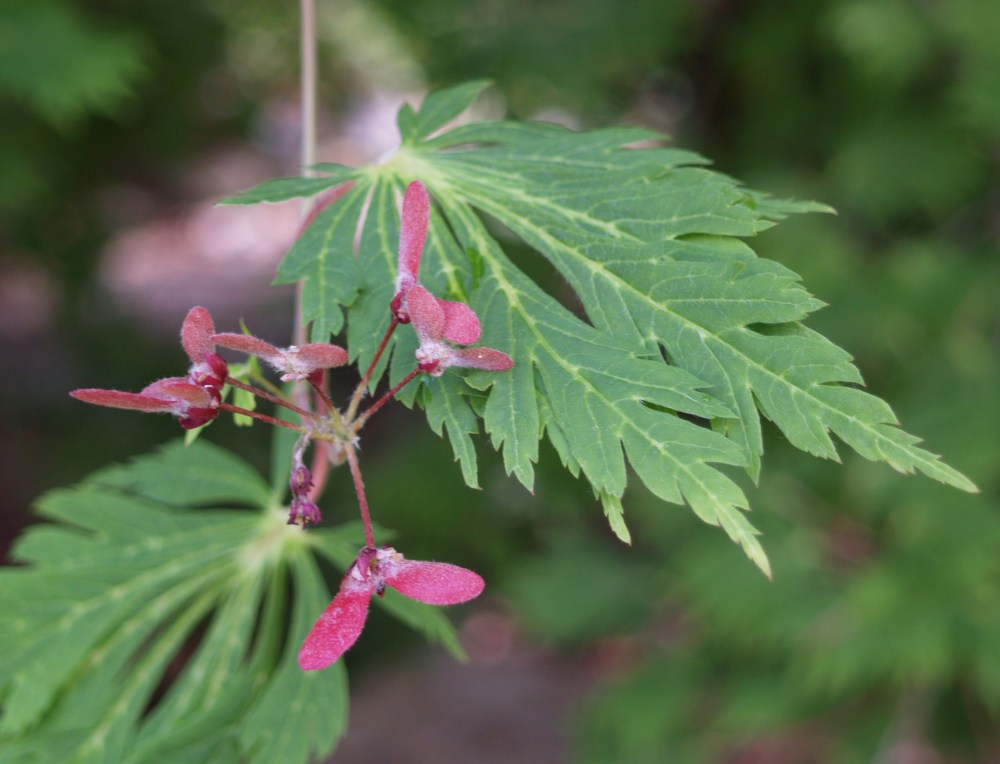
Just as it is inappropriate to choose a favorite child, I prefer not to pick one plant, though there are many, too many, that are “favored”. To a slightly greater degree than others, I am fondest of two maples that are not of the palmatums that are most commonly considered Japanese maples. The Fern Leaf maple, Acer japonicum ‘Aconitifolium‘ (above), also called Full Moon maple, is a wide spreading, upright grower with broad, deeply cut palm shaped green leaves, and the most spectacular mottled fall color. The winged seeds in early spring are also colorful and attractive.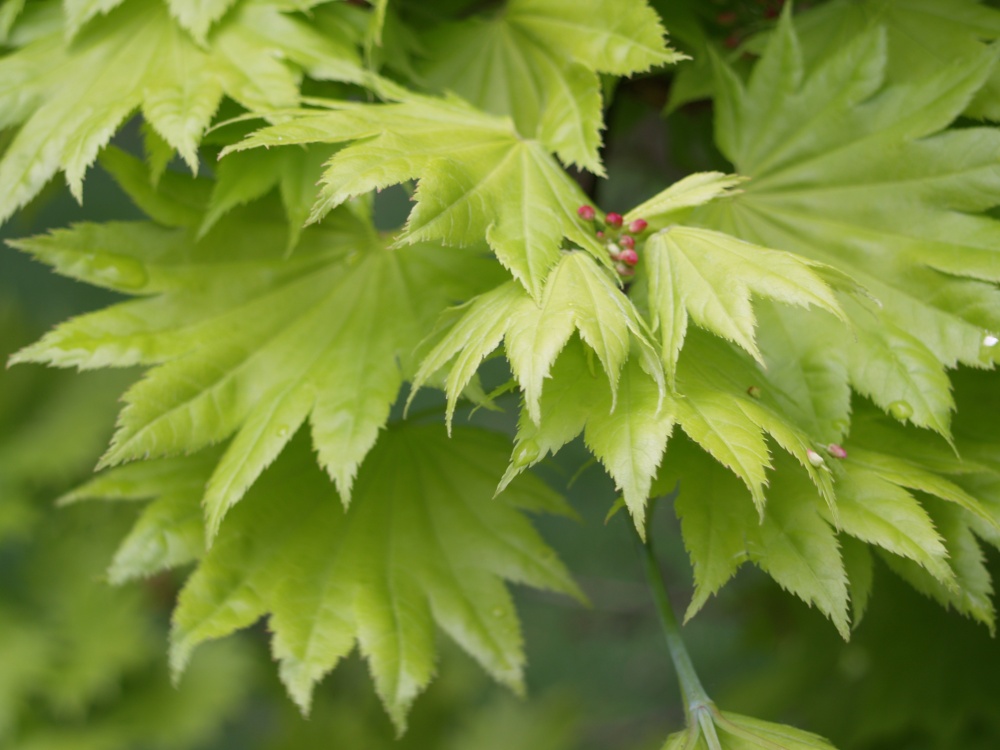
Perhaps because I lusted after it for such a long time before finding a full branched, six foot tall tree with scarred bark, the Golden Full Moon maple, Acer shirasawanum ‘Aureum‘ (above) is at the top of my list of favored Japanese maples, though it is so painfully slow in growth that it can not hope to be a commercial success. The bright yellow-green, nearly round, but dissected leaves are best suited to light shade, though mine is planted in nearly full sun and it suffers only a minimum of leaf scorch.
Now, before I have droned on for too long and must break this down into chapters, I’ll call an end to the listing of Japanese maples in my garden, though there are a handful or more that I have not mentioned. If you are interested I believe that I listed them more completely in April of 2009. You’ll will also see a few photos that are superior to today’s, but then some from today are better.
Terrific Job! Thanks for sharing the beauty of your garden.
RR
I’ve planted three new Japanese maples this spring, and I’m anxious to see them in leaf. In a few weeks I’ll post photos of the updated collection.
which one is the best japanese mape tree ( red leaf only)
thanks
There are many great varieties, but for upright growing varieties Bloodgood has proven to be an excellent tree. Crimson Queen is a popular and excellent weeping type.
hey there! 🙂 I was, and have been looking for a weeping variety of Japanese maple but one that can grow fairly large. I have seen in smaller towns further north (I live on Ontario Canada) some variety’s that are weeping but are taller than 9 feet tall. again thank you and love your collection! 🙂
Many pendulous forms of Japanese maple will grow nearly to ten feet after a number of years, though some will top out at about seven or eight feet tall. I have a ‘Crimson Queen’ that is nearing ten feet after about twenty years, but it’s been transplanted twice which has stunted its growth for a couple years each time. The variety ‘Garnet’ is slightly more upright in form, so I suspect it will be the quickest to gain height. If you are looking for a tall maple the first thing that I would look for is a maple with a tall graft. The same tree can be grafted onto a two or four foot trunk, and the additional two feet will get you to ten feet tall several years sooner.
The pendulous Japanese maples grow in height by layering on top of older branches, so height is gained slowly. ‘Garnet’ is quicker to grow tall because the branches do not arch as much.